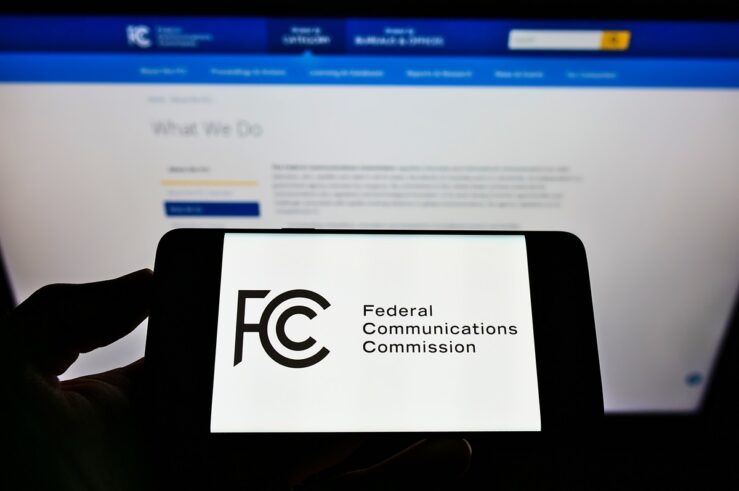
If you’ve been keeping up with the machinations of the Federal Communications Commission’s (FCC) latest attempt to regulate broadband under Title II of the Communications Act, you know that providers are challenging the rules in the 6th U.S. Circuit Court of Appeals. The court has put that case on the fast track.
Earlier this week, the International Center for Law & Economics (ICLE) and the Competitive Enterprise Institute (CEI) submitted an amicus brief urging the court to vacate the FCC’s order.
The Title I/Title II Teeter-Totter
Since the 1990s, broadband internet has mostly been regulated with a “light touch” approach under Title I of the Communications Act. This classification as an “information service” means less-stringent oversight, as compared to the traditional utility-style regulation of a Title II “telecommunications service.” Though broadband has been classified as a Title I information service for most of the 28 years since passage of the Telecommunications Act of 1996, the FCC briefly shifted to Title II regulation from 2015 to 2018, before returning to Title I with the Restoring Internet Freedom Order.
Proponents of Title II argue that it’s necessary to protect so-called “net neutrality” and to ensure fair access to broadband services by edge providers like Google, Amazon, Netflix, and Facebook.
As we have argued in the past, including in several rounds of regulatory comments and amicus briefs, public-utility-style regulation under Title II is unnecessary and harmful. That’s because, under the current Title I approach, the U.S. broadband market is competitive, dynamic, and generally serves consumers well. In the years since 2018, more households have become connected to the internet; broadband speeds have increased, while prices have fallen; more households are served by multiple providers; and new technologies like satellite and 5G have expanded internet access and intermodal competition among providers. Heavy-handed regulation under Title II would slow or stifle these advances.
A Major Question
In our amicus, we argue that reclassifying broadband under Title II triggers the “major questions doctrine,” or “MQD.” This legal principle holds that, for issues of vast economic and political significance, agencies need clear congressional authorization in order to act.
While the FCC argues that the MQD is essentially irrelevant after Loper Bright v. Raimondo repealed Chevron deference, we argue that the doctrine is still applicable as a rule of statutory construction. The overturning of Chevron and the MQD are both premised on protecting the separation of powers. Loper Bright means the Court will no longer defer to agency interpretations of ambiguous statutes when it is not the best reading. The MQD complements that holding by making sure that Congress clearly grants agencies authority to act when dealing with areas of vast economic and political significance.
Why Does Broadband Classification Qualify as a ‘Major Question’?
In his concurrence in West Virginia v. EPA, Justice Neil Gorsuch identified a number of criteria to help identify a major question. One was when an agency seeks to regulate “a significant portion of the American economy.” Another is where an “agency claims the power to resolve a matter of great ‘political significance.’” Both of these are clearly the case here.
- Economic Significance: The United States has more than 130 million fixed-broadband subscribers; the broadband industry generates more than $100 billion in annual revenue and has invested trillions of dollars in infrastructure. Title II gives the FCC broad powers to regulate almost every aspect of broadband deployment and delivery.
- Political Significance: The issue has been hotly debated in Congress and state legislatures for years.
Our amicus argues that the Communications Act doesn’t provide the clear authority needed for such a consequential move. Previous court decisions have found the law ambiguous on this point, which actually works against the FCC under the MQD.
For example, the FCC points to the Supreme Court’s Brand X decision to argue that it has already been decided that the FCC has the authority to classify broadband as a Title II service. But this is a misunderstanding of what that case represents. At most, in his Brand X dissent, the late Justice Antonin Scalia believed that it would be appropriate to apply a telecommunications classification to the access/delivery component of broadband internet service.
If this was the Court’s opinion, then there would be a strong argument that it is settled law that Congress spoke clearly to the issue. But it wasn’t. The majority rejected Justice Scalia’s arguments and found the statute ambiguous as to classifying cable-modem service. In other words, Brand X did not foreclose a challenge under the MQD.
Rewriting the Statute?
Moreover, the FCC’s need to use its forbearance authority to “tailor” Title II to broadband should have signaled that they had taken a wrong interpretive turn. In effect, the FCC employed its forbearance authority to selectively apply only some Title II provisions to broadband. Under what it calls “broad, tailored forbearance,” the commission chose to forbear from enforcing a quarter of Title II’s statutory provisions. Our amicus argues this amounts to the agency essentially rewriting the law to fit its preferences—a move courts have rejected in other contexts.
Most notably, in Utility Air Regulatory Group v. EPA, the Court rejected the Environmental Protection Agency’s (EPA) “tailoring rule” as an attempt to rewrite a statute, concluding that an agency “has no power to ‘tailor’ legislation to bureaucratic policy goals by rewriting unambiguous statutory terms.”
This selective application also creates uncertainty. For every provision the FCC forbears, it reserves the right to “unforbear” in the future, potentially leaving broadband providers in regulatory limbo.
Vague Rules, Big Consequences
Our amicus takes particular issue with the vagueness of the FCC’s new rules. While there are some “bright-line” prohibitions—such as the bans on blocking, throttling, and paid prioritization—much of the regulatory framework relies on case-by-case evaluation. Indeed, even the bright-line prohibitions have exceptions that will be evaluated by the commission on a case-by-case basis.
Even worse, the commission’s “general conduct rule” gives the FCC broad discretion to determine what practices are harmful. The order describes the general conduct rule as “a backstop mechanism” to police conduct not covered by the bright-line prohibitions. But rather than a “backstop,” the general conduct rule is a catch-all that would allow the commission to intervene if it doesn’t approve of a provider’s policies or practices.
As “guidance,” the commission proposes a nonexhaustive list of factors that could possibly (but not necessarily) be used to prove a violation under the general conduct rule. The factors comprise an uncertain mashup of competition law, consumer-protection law, and First Amendment law and include: effects on end-user control; competitive effects; effects on innovation, investment, or broadband deployment; effects on free expression; whether the conduct is application-agnostic; and whether the conduct conforms to standard industry practices. That is to say, essentially any action implicating anyone or any firm interacting with any part of the internet.
This guidance, however, is unhelpful. While the order does not ban zero rating, data caps, and usage-based billing, the order is clear that these practices will be scrutinized and evaluated on a case-by-case basis under the general conduct rule. This places providers in a legal gray area, where some practices are neither banned nor clearly permitted until they receive review by the FCC.
Moreover, under Title II, Section 214 requires providers to obtain the FCC’s approval before constructing new networks, offering new services, discontinuing outdated offerings, or transferring control of licenses. The order forbears from Section 214 exit-certification requirements regarding the discontinuance, reduction, or impairment of broadband internet-access services.
The order, however, does not forbear from certification requirements regarding authority for entry and acquisitions (including transfers of control and assignments). Instead, the commission grants “blanket authority” to all current and future broadband providers (with the exception of several Chinese companies), “subject to the Commission’s reserved power to revoke such authority.”
The commission argues that granting blanket authority is superior to forbearance, in part, because it preserves the FCC’s “ability to protect consumers and the public interest by withdrawing such grants on an individual basis.” Despite this blanket authority, the commission reserves the right to “withdraw[] such grants on an individual basis.”
While blanket authority might seem like a compromise between full regulation and forbearance, its ambiguous nature can actually create more problems. Blanket authority creates a gray area where broadband providers are neither fully regulated nor fully exempt. This can lead to confusion about which aspects of Section 214 still apply and to what extent, especially with the commission’s ability to “revoke” or “withdraw” such authority “on an individual basis.”
Thus, despite the FCC’s assurances that blanket authority “removes barriers to entry,” the specter of case-by-case revocation of such authority will lurk behind every investment or acquisition subject to Section 214, leaving providers subject to the arbitrary and capricious whims of the current and future FCCs.
This vagueness in the FCC’s Title II order creates several problems:
- Regulatory Uncertainty: Broadband providers can’t be sure if their business practices will be deemed acceptable.
- Chilling Effect on Innovation: Companies may be hesitant to launch new services or invest in infrastructure improvements.
- Potential for Arbitrary Enforcement: The FCC could apply rules inconsistently or use them to target specific companies.
The amicus argues that this vagueness makes the rules “arbitrary and capricious,” and grounds for vacating the order.
Economic Impact
While the FCC claims the economic impact will be minimal, our amicus cites research suggesting Title II regulation could significantly decrease investment in broadband infrastructure. The uncertainty created by the new rules may make companies less willing to commit to long-term, capital-intensive projects.
The brief criticizes the FCC for dismissing these concerns without providing its own quantitative analysis of the potential costs. The most curious example involves research by Wolfgang Briglauer and his co-authors published in the European Journal of Law and Economics. ICLE summarized this study in its comments to the FCC:
Using panel data from 2000 through 2021, Briglauer and his co-authors find evidence that net-neutrality regulations have a significant negative impact on fiber-optic network investment by internet service providers. They employ several econometric techniques, including fixed effects and instrumental variables models, to establish evidence of a causal relationship between net-neutrality rules and reduced investment. The main finding is that the introduction of net-neutrality regulations leads to an estimated 22-25% decrease in new fiber-optic network investments by ISPs.
The FCC’s order published in the Federal Register notes, “the underlying data for this study were not available to us in our analysis.” Nevertheless, the agency claims to make “corrections” to the paper to conclude “there is no empirical evidence in the record that Title II reclassification would have any significant negative impact on broadband investment.”
The commission provides no explanation of what “corrections” were necessary, how the corrections were made, or how those corrections could have been made without access to the underlying data. The FCC’s unexplained rejection of published peer-reviewed academic research has the hallmarks of “a serious flaw undermining that analysis” that “render[s] the rule unreasonable” under National Ass’n of Home Builders v. EPA.
Conclusion: Title II Faces a Rough Road Ahead
In a unanimous ruling earlier this month, the circuit court stayed the Title II rules, finding that the petitioners—broadband providers challenging the rules—are likely to succeed on the merits, as the FCC’s rules implicate a “major question” requiring clear congressional authorization, which the court determined is likely lacking in this case. ICLE and CEI’s amicus supports this view:
- It violates the major questions doctrine by asserting broad authority without clear congressional approval.
- The use of forbearance to apply Title II rules selectively amounts to an improper rewriting of the law.
- The vagueness of the rules makes them arbitrary and capricious.
- The FCC failed to adequately consider evidence about the negative economic impacts.







